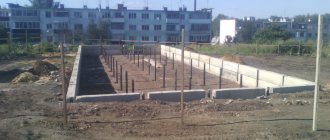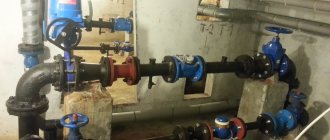Repairs in an apartment building are an expected and costly event. Since the addition of the additional line “major repairs” to the receipts, this type of repair has become a stumbling block between housing and communal services and the residents of the house. Many believed that the funds paid under this line could be spent on any repairs in the house, but in reality this turned out not to be the case, which logically caused a wave of indignation. Now, after some time, loud debates on the topic of major repairs have subsided; in practice, several thousand major repairs have already been implemented, which the residents of the building paid for on their own. Today we will look at what exactly is a major overhaul, how often it is carried out and, most importantly, at whose expense it is paid.
Major repairs of utility networks: types
The definition of this type of repair is contained in the Town Planning Code of the Russian Federation, also known as Federal Law No. 190-FZ in the latest valid edition as of December 31, 2017. So, overhaul means:
- replacement of building structures, elements or their restoration;
- replacement of technical systems/refurbishment;
- replacement of parts of supporting structures/restoration.
When overhauling, the object is of great importance; it is important that it belongs to capital construction. During a major overhaul, the communications of a residential building are replaced or restored, which are important for the functioning of the entire apartment building, otherwise the building would be incomplete without them.
For example, repair of utility networks in an apartment building involves replacement or partial replacement (restoration) of elements or the entire electrical wiring of the house, replacement of hot and/or cold water risers (hot water supply/hot water supply).
Unlike current repairs, overhauls are characterized by rigid boundaries, these are:
- periodicity;
- duration;
- capital repair fund;
- estimate of necessary activities.
Most often, the most important utility networks are subject to major repairs. Repair of utility networks as part of a major overhaul includes repair work or replacement of:
- water supply;
- gas pipeline;
- electrical networks;
- sewerage;
- gas supply networks.
As you can see, without the normal functioning of the above networks, living in a house can be not only difficult, but also dangerous. For example, untimely replacement of electrical wiring can lead to a short circuit and fire.
What types of repairs are there for in-house engineering systems?
Repair of in-house engineering systems is one of the types of work performed as part of the maintenance of the facility’s engineering communications. Scheduled and emergency repairs of utility networks are carried out by specialists of the appropriate profile with a preliminary assessment of the system condition and task planning.
The continued safety of the facility and the comfort of its operation depend on how well the work is completed. To reduce the need for repairs, it is important to carry out scheduled inspections and diagnose equipment in a timely manner, including using precision measuring instruments.
Repair of in-house engineering systems: service composition
Repair of in-house engineering systems is relevant for all types of engineering communications of the facility. Any building or structure requires periodic repairs of the following types of utility networks:
- plumbing, water supply system and all equipment included in it;
- sewerage and drainage system;
- gas and fuel boilers, heating radiators, heaters;
- equipment working with gas;
- electrical wiring and appliances;
- ventilation and air conditioning system;
- elevators;
- communication systems, television, security, alarm, fire safety.
Repair services for in-house engineering systems include work only with internal equipment. If repairs of utility networks are required outside the facility, it is carried out with prior agreement on the timing of the work. All residents and workers of neighboring buildings are informed if they have to turn off the water, gas or heating system.
In-house repairs can be carried out at any time, as long as they are not associated with a power outage to neighboring facilities. It is planned taking into account existing problems. In emergency cases, repairs are carried out urgently if this is necessary for the full functioning of the facility.
What types of repairs are there for in-house engineering systems?
Types of repairs of in-house engineering systems include:
- current work - replacing worn out mechanisms, changing consumables, measuring and measuring performance indicators, setting up and debugging equipment, preventive inspections, installing new equipment or upgrading old equipment;
- capital works - complete replacement of a section of the network, the entire network, re-equipment, redevelopment, complete or partial replacement of pipes, wiring, metering and distribution devices;
- emergency work - repairs that are performed in case of breakdowns that lead to the impossibility of full use of the facility.
Repair of utility networks, except in cases of emergency work, is carried out according to schedule. The schedule calculates the timing of scheduled inspections. On them, the technician can see the problem in advance and plan the time to fix it.
Repair of in-house engineering systems for each network has its own specifics. The situation is easiest with equipment that is autonomous or powered only by electricity or gas. The most difficult issues are related to the heating system. It is operated seasonally and requires constant monitoring of condition and preparation for wintering, and inspections after the heating season.
How often are repairs to in-house engineering systems carried out?
The frequency of repairs of in-house engineering systems depends on the characteristics of the facility. Planned repairs of utility networks are prescribed by technicians based on the results of inspections. For some objects it is enough to carry it out once every five years, and for some it is necessary to do it annually.
The time frame for major repairs of in-house engineering systems varies for each network. Heating supplies are replaced every 25 years. Water supply - once every 15 years. Electricity - once every 20 years. Sewer risers need to be replaced every 40-55 years, depending on the material.
It is important to carry out current and major repairs with maximum responsibility. The possibility of breakdowns and other troubles during use depends on the level of work performed. It is convenient when the repairs are carried out by the management organization that manages the facility. She is familiar with all the features of the structure and its real needs.
Source
Current or major repairs in an apartment building
The previous paragraph discussed the distinctive features of a major overhaul. In fact, they are what distinguishes a major overhaul from a current one, because... It makes no sense to consider these two types of repairs solely by type of work. The fact is that the fixed list of repair work in the house can be carried out both as part of ongoing replacements and major ones. The difference is in the scale of work. For example:
- roof waterproofing;
- insulation of building facades;
- replacement of window frames in the entrance;
- replacing doors at the entrance;
- renovation at the entrance (cosmetic).
Before starting repairs, housing and communal services employees assess the current state of the system. So, if the deadline for a major overhaul has not arrived and the system can be used, then it is repaired as part of the ongoing repair, otherwise it is put in line for replacement during the overhaul of an apartment building.
As a rule, each region approves the order of major repair work, because For this purpose, appropriate communications are purchased, a certain amount of funds is allocated, etc.
Types of engineering systems of a residential building
Support for comfortable conditions and normal functioning of a residential building is provided by a whole range of engineering systems. The main ones include the following communications:
- cold and hot water supply;
- water disposal and sewerage;
- heat supply;
- gas supply;
- electrical wiring and low-current networks;
- ventilation;
- garbage chutes;
- elevator facilities, etc.
Not only the convenience, but also the safety of residents depends on the technical condition of these networks. This places increased demands on the timeliness and quality of restoration work. This especially applies to the repair of in-house gas supply systems, electrical wiring and other utility networks.
How often are repairs carried out?
Frequency is the time period for major repairs, i.e. the period during which major repairs must be carried out. The deadline is set for each type of work.
If we consider the timing of major repairs, they can be divided into two groups:
- Deadlines.
- Reasonable deadlines.
The established period is determined by agreement, contract or regulation. If the period is not determined by the above methods, then major repairs must be carried out within a reasonable time. The concept of “reasonable time” is the subject of consideration in civil law. Thus, when determining the period for major repairs in an apartment building, the following factors should be taken into account:
- state of the utility network;
- type of utility network;
- peculiarity and intensity of operation;
- assessment of the consequences of untimely repair of the utility network;
- technical and material capabilities, etc.
The timing and frequency of major repairs are established in the Housing Code of the Russian Federation.
The frequency of repairs is individual in each region of the Russian Federation (determined based on external and climatic conditions). For example, in the middle zone, with the exception of destructive and other unfavorable factors not typical of the normal climate, major repairs of an apartment building are carried out once every 25 years. Similar repairs in the northern regions are carried out once every 10 years.
Various standards set deadlines and establish the frequency with which major replacement of structures must be carried out. All kinds of GOSTs set deadlines for major repairs. For example, GOST 286-62 determines the service life of sewer plastic pipes at 60 years. If during the specified period there have been no serious changes in the nature of the operation of the systems, then repairs are carried out no earlier than scheduled.
If you want to find out the time frame for major repairs in your home, you can use one of the following methods:
- contacting the Management Company (if the HOA, then the chairman) with a corresponding request;
- contacting the administration (district or city) with a request for information about whether your house is included in the program and when a major replacement is planned;
- on the website of the Fund for Assistance to Reform of Housing and Communal Services. If your house is included in the program, then you can find out not only the deadlines for the work, but also their list.
Scope of work for major repairs
The list of works during major repairs is individual for each type of utility network. It also depends on their technical condition and configuration features.
When repairing in-house heating and water supply engineering systems, risers and distribution lines, shut-off, shut-off and control, and safety valves are replaced. Pumping and control equipment may change. Heating networks additionally provide for system balancing, replacement or repair of air vents, installation of an individual heating point and other equipment. Heating radiators or other heating devices in common areas are being replaced.
Major repairs of water drainage and sewerage include the replacement of sewer risers and deck chairs. The internal drainage of the house is also changed or reconstructed, and a drainage system is installed. Sewage valves are being installed, which ensure more comfortable use of the system and prevent emergency situations.
The overhaul of in-house power supply systems includes the replacement of electrical wiring and input and distribution devices. New house, entrance, and floor electrical distribution panels are being installed, and protective equipment is being changed. This also includes the replacement of general building lighting networks, emergency lighting, and outdoor lighting. Photoswitches and other advanced equipment can be installed to increase the efficiency and economy of the system. The power supply networks for the engineering equipment of the house are changing.
Is it possible to carry out repairs earlier than planned?
It's no secret that major repairs are sometimes needed earlier than planned. Let’s say that utility networks in an apartment building need to be repaired now, but major repairs will only take place in 5 years, what in this case?
Theoretically, it is possible to carry out major repairs ahead of schedule, but in practice this is complicated by a number of reasons. Even if the repair deadline has been extended, it will not be urgent.
Let's look at Article 189 of the RF Housing Code. It says that before the beginning of the year in which major repairs of the house should be carried out, but no later than 6 months, the person who is responsible for the maintenance of the property of the house is obliged to notify all home owners, hold a general meeting to approve and agree on estimates, types of work, etc.
To start a major overhaul, you need to contact the management company to which the house is attached. Request an inspection of the communications network that is causing the most concern. If the company makes a decision about the unsatisfactory condition of the systems, then there will be an extraordinary overhaul, although not earlier than in six months.
How to request ahead of time?
According to the regulations, major repairs of a building's engineering systems, for example, major repairs of a pipeline, can be carried out ahead of schedule only if a real threat to the life and health of the residents of a particular building is proven .
To make this possible, changes need to be made to the regional overhaul program, i.e. local government bodies, management organizations or homeowners' associations must submit an application to the relevant executive authority that deals with this issue.
Naturally, the decision to carry out major repairs earlier will be made only after a series of inspections and examinations of the condition of the building.
It is worth noting that to request repair of engineering systems you need to write a statement. It is designed in a free style according to the generally accepted pattern.
When starting to write an application, you should start by drawing up a header, which states to whom the application is being sent (position, company name), followed by the surname, first name and patronymic of the manager, the applicant’s initials, address and contact telephone number).
The body of the application states the essence of the problem (for example, a major overhaul of heating networks is required), indicates when the last inspection was carried out, and adds descriptions of the condition of engineering systems. This is followed by the date and signature of the applicant.
As a rule, you have to wait 10 working days for a response from the management company, which is REU, ZhEK or REMP.
At whose expense is the repair carried out?
Who pays for repairs in an apartment building is the most pressing issue. Pay attention to the receipt that is sent monthly with charges for utilities, namely the column “contributions for major repairs.” This is one of the sources of the formation of the fund from which payments for major repairs are made. However, this does not mean that the residents of the house pay monthly for repairs in their house and the amount accumulates until the date of its completion. The payment fund is common to all houses of the management company. Therefore, funds for repairs come from general money.
According to the Housing Code of the Russian Federation, the owner bears all costs of maintaining the house. This norm has been enshrined in the code since 2005, but in fact the implementation of this payment began not so long ago. Minimum payments are established by the constituent entities of the Russian Federation and are calculated for each square meter of property. For example, in Moscow the minimum payment is set at 15 rubles per square meter. Thus, the owner pays 350-1000 rubles monthly, considering that the average area of an ordinary Moscow apartment is 23-60 square meters.
If you found this page useful, please recommend it to your friends:
Corrosion is a common problem in water supply networks.
The appearance of corrosion on pipes does not lead to a deterioration in the operation of the entire water supply network; internal corrosion is much worse. To eliminate this phenomenon, it is not enough to use certain chemical components; it is necessary to change the composition of the water by installing additional filtration systems.
Elimination of corrosion:
- Stabilization method. At the first stage, water is treated with special compounds that contain aggressive microelements. After this, the water passes through a dolomite filter system. After the stabilization method, corrosion ceases to appear on pipe surfaces.
- Deaeration method. It is similar to the stabilization method, only instead of dolomite filters, steel particle stations are installed. Not only harmful impurities are removed from water, but also gaseous substances.
You should know that the process of corrosion formation accelerates with increasing temperature. To eliminate this negative effect, water flow regulators should be installed. These devices allow you to control and prevent corrosion, but require technical inspection. We should also not forget about timely cleaning of the pipeline from harmful contaminants.







